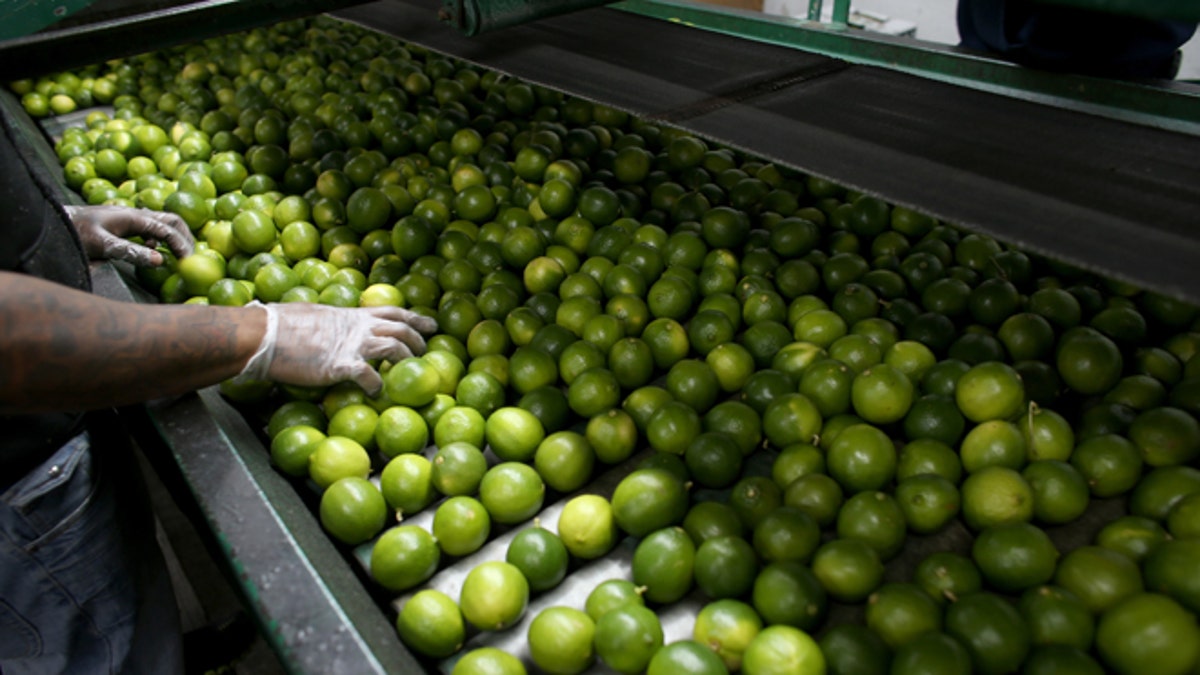
MIAMI, FL - MARCH 26: Dairoby Aldana sorts limes that have been imported from Columbia at SA Mex produce on March 26, 2014 in Miami, Florida. Samuel Rosales from the produce company said they hadn't received any lime imports from Mexico for the last three days as a tight supply in Mexico has driven up the availability as well as the prices for the citrus in the United States. (Photo by Joe Raedle/Getty Images) (2014 Getty Images)
Inside the rustic, lowly-lit Hecho en Dumbo restaurant, heaping plates of Conejo en Chileajo and Pescado a la Talla are served up to hungry customers sipping freshly-made margaritas at this chic Mexican eatery located in Manhattan’s Bowery neighborhood.
As cooks rush back and forth inside the open kitchen, braising pork and adding dashes of cilantro to short rib tacos, chef and co-owner Danny Mena mulls over the list of provisions that he needs to stock his freezer.
While one would think that Mena would be most concerned with the cost of the pricey cuts of the meat he has to order or the top-shelf liquor that sits behind the restaurant’s marble bar, the one food that is on his mind – and that of restaurateurs across the country - is a small citrus fruit that tops everything from tortas to tequila drinks: the lime.
“You take the good with the bad but this is getting brutal,” Mena told Fox News Latino. “The lime juice is now costing us more than the alcohol.”
The price of limes has sky-rocketed in the last few months thanks to a mix of damaging storms in prime growing regions in Mexico, the deadly "Huanglongbing" bacterial disease that devastated crops on both sides of the border and even the incursion of drug cartels into the Mexican citrus trade.
Limes are primarily grown in the state of Michoacán, which besides being fertile land for growing limes, is also the home turf of the Knights Templar drug cartel. Some analysts say that besides the wholesale hijacking of limes, the Knights Templar have helped drive down the production of limes and drive up the cost at markets but levying heavy taxes on growers in the region known as "La Tierra Caliente," literally "hot land."
Mexico began producing more than 90 percent of the limes now consumed in the United States after a devastating 2001 citrus canker outbreak handicapped the Florida citrus industry, for which it never really recovered. While some citrus is grown in California, it is not enough to meet the U.S. demand and distributors have been forced to rely on the now beleaguered Mexican crops – passing on the high costs to their own buyers.
“It used to pay $25 for a case of limes,” Mena said. “Now the highest I’m paying is $147.50 a case. It’s getting tough to keep our prices the same.”
Mena said that as of now his restaurant has only had to raise the price of their margaritas by $1 and will not be substituting any other citrus fruit for the pricey limes in the near future. But, he said, if the prices continue to soar he’s not sure how much longer the restaurant can operate without taking drastic measures.
Mena’s lime lament is a story repeated in kitchens across the country as restaurant owners deal with high-prices and high demand for the citrus fruit. Besides just riding out the shortage, some restaurants are either cutting back on how many limes they use in their food and drinks, searching for alternatives to the citrus fruit or cutting out the use of limes from their kitchens altogether.
“I completely cut off using limes because I just can’t afford it,” Carlos Gaytan, the chef at Chicago’s Mexique restaurant, told Fox News Latino. “There is not much I can do right now except to try to get creative and work around the shortage by using substitutes like lemons.”
Some restaurant owners say that, so far, their customers have either not noticed or not complained about the lack of limes in their tacos, but the problem is expected to hit consumers more as the price of the fruit goes in up in stores. Supermarkets on the east coast are charging around $1.60 for a single lime – with some prices soaring as high as $3.
Now with Cinco de Mayo – the annual celebration of the 1862 victory by Mexican forces over French troops – fast approaching, the need for limes to be put in salty margaritas and Mexican beers is even greater. But analysts, however, warn that prices probably won’t come down until the end of May and be back to normal until mid-summer when the next batch of crops can be harvested.
Until then, chefs will just have to get creative and hope for a bountiful harvest.
“I’m just hoping this summer will be generous,” Mena said. “Right now, we just need to stay afloat.”
